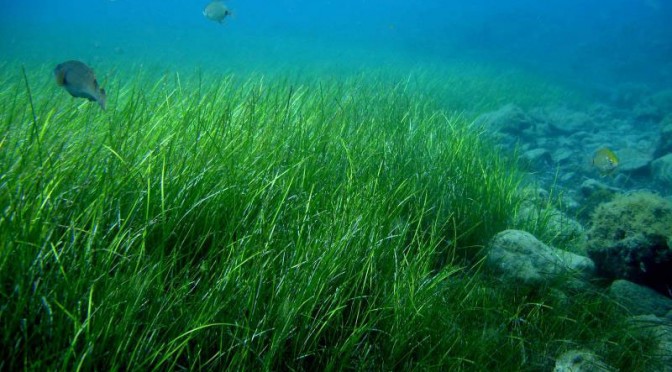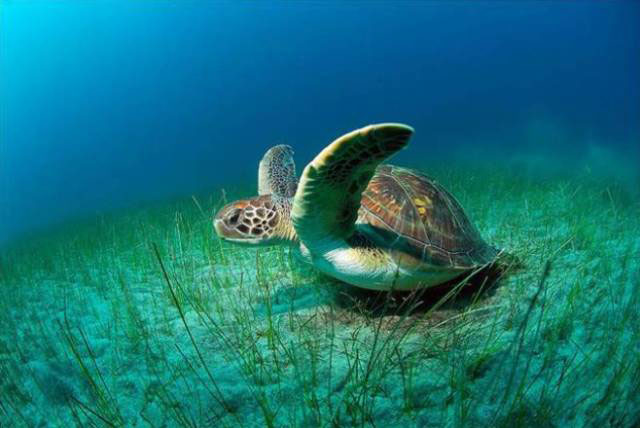In our FuerteCharter daily routes, with trips from Corralejo, we go through an area of interest as a marine ecosystem: “Los Sebadales” in Corralejo.
Fuerteventura is the island in the archipelago having the largest number of fine golden sand beaches, and this is why it’s known as “La playa de Canarias”. These extensive sandy areas, partly submerged, give place to the meadows of marine phanerogams — similar to the grass— but unlike seaweed they have roots (a great deal of them, so as to anchor to the sandy soil), stems and leaves.
Marine phanerogams need a salinity ranging from the 30% to the 37%, receiving the necessary light radiation to conduct photosynthesis (which is why they are located between the intertidal area and the 60m bellow the surface when the waters are clean and clear), be anchored to a substratum of quality and be surrounded by clear nutrient-rich waters.
Out of the 66 species of marine phanerogams spread all over the world, in The Canary Islands we have 4 of them, Cymodocea nodosa, popularly known as “seba”, standing out. Etymologically, Cimódoce was one of the sea nymphs in the Greek mythology, and nodosa makes reference to the presence of knots.
Distribution
The meadows of C.nodosa, “sebadales” or “manchones” are mainly located in the most protected bays in the East, South East, South and South West, in Fuerteventura as well as in the rest of the islands. They predominate in the oriental islands, which are older and further eroded, so they have the best sandy soil.
Due to the seasonality of the vegetative growth, “los sebadales” look different depending on the season of the year. The average peak values, regarding density of feet, height, number of leaves and coverage are reached in Spring and Summer, showing more foliage and a deep green colour.
Morphology and anatomy
“La seba” is an herbaceous perennial plant, with a rugged stem (rhizome) featuring knots from where leaves sprout upwards and the roots downwards. In the ancient times the stems were chewed, as they had a sweet flavour and they were called “reveriñas”.
The leaves are long (10-70 cm) and narrow (4mm), grouped in 2 or 4 beams, being able to reach the 10 beams.
The elongation of the rhizome parallel to the soil allows the plant to spread very quickly in the case of “la seba”, being able to form a meadow in just one year.
This would be a plagiotropic growth, but orthotropic or vertical growth can also take place, helping the meadows keep their leaves over the soil when, after a storm, a great deal of sediment has covered “los sebadales” at the bottom. Thanks to this kind of growth the leaves emerge again from the sedimentary surface.
Reproduction
Like other marine phanerogams, “la seba” can reproduce itself sexually, forming flowers, fruits and seeds, or in an asexual way (cloning) by elongating their rhizomes and forming new beams with identical genetic information.
The importance of “los sebadales”
– They provide food and shelter to many species, being a very rich habitat in biodiversity: seaweeds (up to 53 species), fish, cuttlefish, worms, seashells, crustaceans, molluscs, echinoderms… sometimes they are even visited by our dear loggerhead turtle. They are also a laying site for many of these species, and they are considered as marine nurseries, where juvenile and restocking fish are bred.
– They generate oxygen and a great deal of biomass thanks to the photosynthesis.
– They play and important role in recycling nutrients: they catch and produce debris and excrete dissolved organic matter.
– They cushion the impact of the swell and the ocean currents on the seabed, thus preventing coastal erosion as they keep the sediments thanks to their roots and rhizomes.
– They improve the quality of the water, increasing its water transparency and behaving like a biological indicator of the high degree of preservation of the coastline, that is, they ensure the best waters to bathe in.
“Los sebadales” are very sensitive plants and as we have already said they need particular environmental features in order to develop. When they change and they reach values that exceed their tolerance range the plants suffer from environmental stress; if the changes remain or intensify they can deteriorate and even die, which makes meadows disappear. When they disappear, so do the services they provide like productivity, biodiversity and preservation of the coastline. So it is up to us to preserve these environmental features as stable as possible.
With our trips from Corralejo we try to show our visitors the charms of this paradise and inform them about the fauna and flora that inhabit this biodiversity-rich corner of the planet.
FuerteCharter‘s Team.

